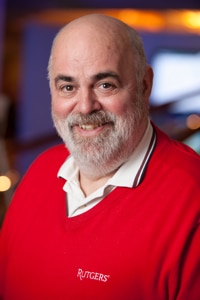Greg Jarboe, President and Co-founder of SEO-PR, is a go-to source in the online marketing industry when it comes to video marketing. He’s a faculty member at Rutgers for the Mini-MBA: Digital Marketing program and at Market Motive. Smart, right? Greg regularly contributes to online publication Search Engine Watch and authored YouTube and Video Marketing: An Hour A Day (published in 2009). So, what do Greg and the Stone Age have in common? When you find out his favorite comedy (keep reading!), it will all make sense!
Coming up in a couple of short weeks, Greg will share pure insight during his session, “Secrets of Mobile Video: YouTube and Instagram and Vine, Oh My!” at SES San Francisco.
We had a chance to catch up with Greg and ask him some questions regarding his take on recent industry developments. He did not disappoint. We hope you enjoy the interview.
AIMCLEAR: Hello, Greg! Thanks for your time today. Let’s hear a little bit about you before we get started. What’s your background? Where are you from? How did you get where you are today?
Greg Jarboe: My background is checkered. I was a journalist before becoming a PR guy before learning SEO before co-founding SEO-PR. As for where I’m from, I was born in California, raised in Texas, New York and Michigan, and I now live in Massachusetts. And how I did I get where I am today? Well, John F. Kennedy was once asked how he’d become a hero. He replied laconically, “It was involuntary. They sank my boat.” So, I worked at Wang Laboratories … when word processors were hardware. Then I worked at Data General … when mini-computers were big. Then I worked at Lotus Development Corp. … when Lotus 1-2-3 was popular. Then I worked at Ziff-Davis … when it published magazines. Then I worked at a dot com … until the bubble burst. So, my entire career has prepared me to work in an industry where Google changes its algorithm 500 times a year and 100 hours of new video content is uploaded to YouTube every minute.
AIMCLEAR: It sure sounds like you’ve gotten to taste a little bit of everything that has led the industry to where it is today! What would you say is the biggest change in video/video advertising in recent years? Why is it so important for the industry?
Greg Jarboe: In recent years, the biggest change in video has been the growth of YouTube. More than 1 billion unique users visit YouTube each month. And, according to comScore Video Metrix for June 2013, viewers spend more time watching videos on YouTube than on the other top five online video properties – AOL, Facebook, VEVO, Yahoo!, and Hulu — combined. In fact, according to Nielsen data for March 2013, YouTube tops all cable networks in the US in reaching 18-34 year olds, ahead of TBS, FX, Comedy Central, AMC, MTV, E!, and ESPN. As for video advertising, the biggest change in recent years was YouTube’s introduction of TrueView in December 2010. TrueView Video Ads give viewers choice and control over which advertiser’s message they want to see and when. And YouTube charges advertisers only when a viewer has chosen to watch their ad, not when an impression is served.
AIMCLEAR: It really is astounding to realize the full breadth of YouTube’s popularity! You’ve been in the online marketing game for a while and know what’s important. What are the top three things a video magnate such as yourself would say every video marketer should be well-versed in today?
Greg Jarboe: I’m not a video magnate; I’m just a video marketing expert. Trust me: the pay scale is very different. Nevertheless, here are the top three things that every video marketer should be well-versed in today: How people discover, watch and share videos. In order to get people to discover your videos, you need to know how to optimize them. In order to get people to watch your videos, you need to know how to create content that is unique, compelling, and entertaining or informative. And in order to get people to share your videos, you need to know the psychological responses and social motivations that trigger sharing.
AIMCLEAR: Right on! That makes sense. If you could snap your fingers and create a tool for video and video advertising, what capabilities would it have? Why do we need it?
Greg Jarboe: Actually, one of the tools that we need for video and video advertising was just launched on Aug. 1, 2013, by Tubular Labs. Tubular’s real-time dashboard enables brands, digital studios, and creators to identify and engage superfans and influencers as well as grow their audience on YouTube. This enables users to:
- Understand the audience composition, viewing preferences and interests of any audience on YouTube.
- Search comments of any channel or video for influencers, questions or keywords.
- Learn when their audience is active and receive a suggested best time to post.
- Engage their superfans and influencers in any geographic location, effortlessly.
- Find new collaborators or promotional partners and track their success of collaborations and promotions.
- Benchmark growth against peers or competitors.
And I didn’t even have to snap my fingers for it to appear!
AIMCLEAR: Well, if that doesn’t get my video heart pumping, I don’t know what will. Now, let’s have some fun! If you could watch only one movie for the rest of your life, what would it be and why?
Greg Jarboe: Only one movie for the rest of my life!?! Well, then it would have to be History of the World, Part I by Mel Brooks. Why? It looks at what really happened throughout time before YouTube was invented – including the Stone Age (where Sid Caesar plays the first artist), The Old Testament (where Brooks plays Moses), The Roman Empire (where Brooks plays a stand-up philosopher), The Spanish Inquisition (where Brooks plays Torquemada), and the French Revolution (where Brooks plays the King).
AIMCLEAR: Great choice! At SES San Francisco this year, you’ll be speaking about the “Secrets of Mobile Video: YouTube and Instagram and Vine, Oh My!” Can you give us a little peek into what you’ll be discussing?
Greg Jarboe: If I gave you a little peek, then I won’t be discussing “secrets” anymore, will I? All I can tell you (hint, hint) is this: If you attend this session, you’ll get answers to these questions:
- Who are the people most likely to discover, watch, and share your mobile videos?
- What steps should you take to create a mobile video for YouTube, Twitter, and Facebook?
- When should you start building a cohesive mobile video strategy and viewing experience?
- Where should you optimize your mobile videos to reach the widest possible audience?
- Why is it important to reach consumers when they’re on foot, on the road, or in the store?
That’s my story (wink, wink) and I’m sticking to it.
AIMCLEAR: Haha, alright, alright. We’ll take it! Thanks for your time. It’s been a pleasure. We’ll see you in San Francisco in a few short weeks. Safe travels!
Well, that’s a wrap for now. Stay tuned as we share more pre-SES San Francisco coverage in the coming weeks!










